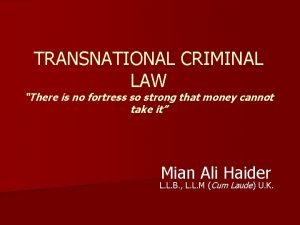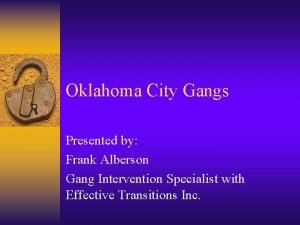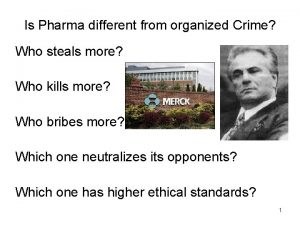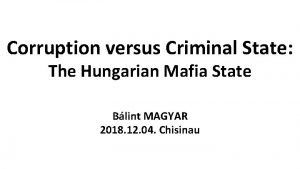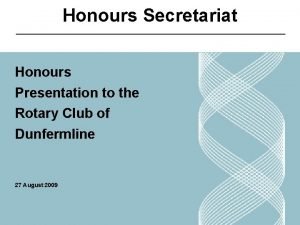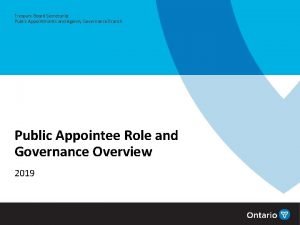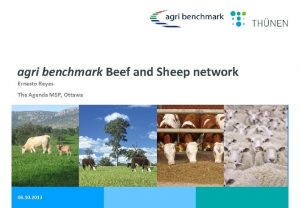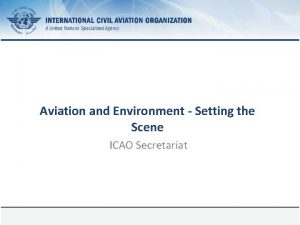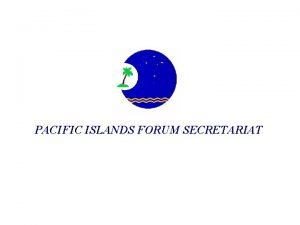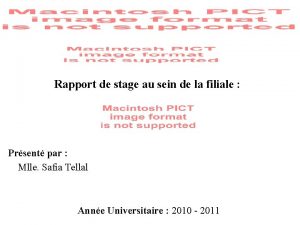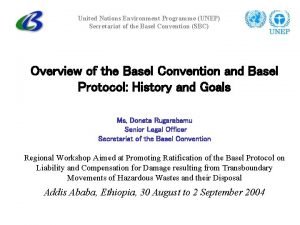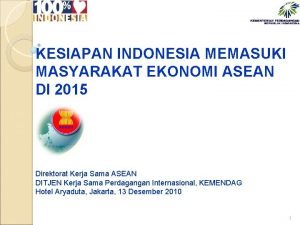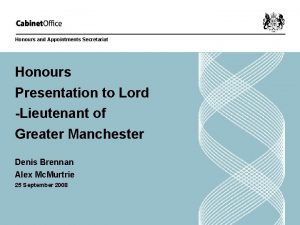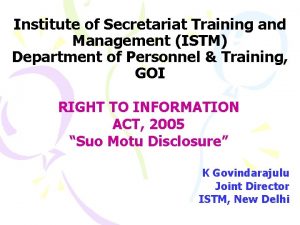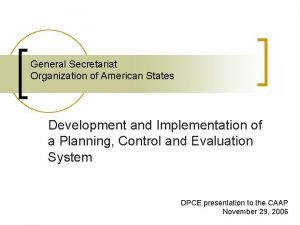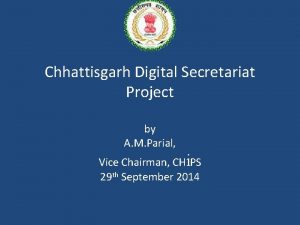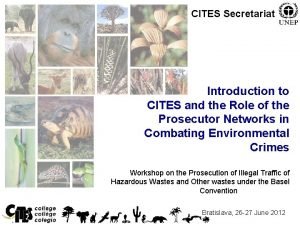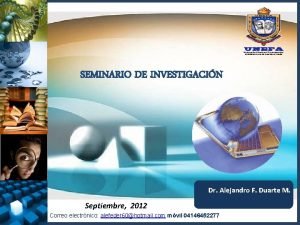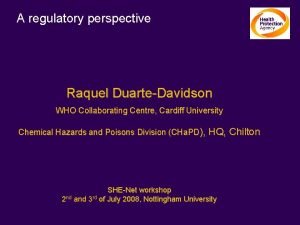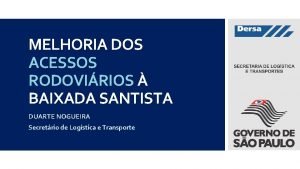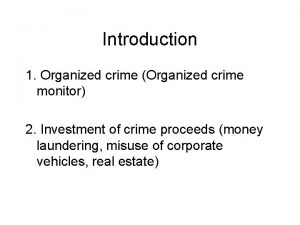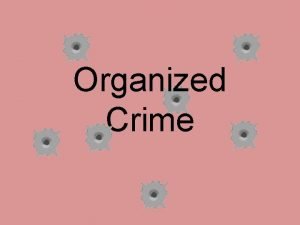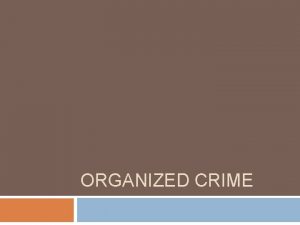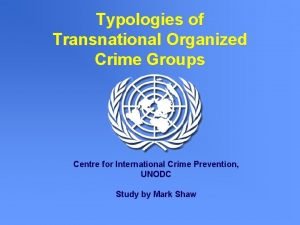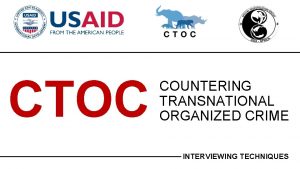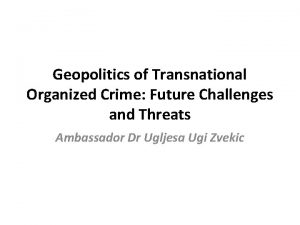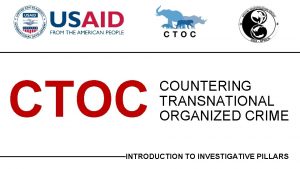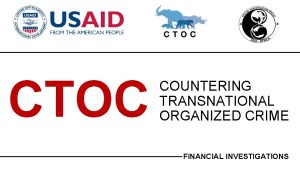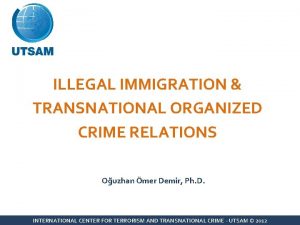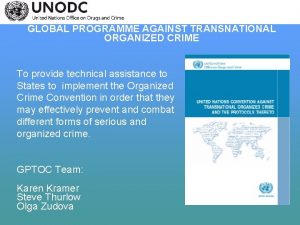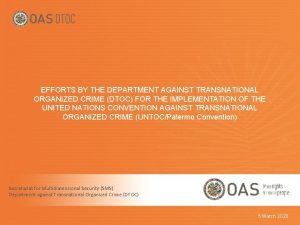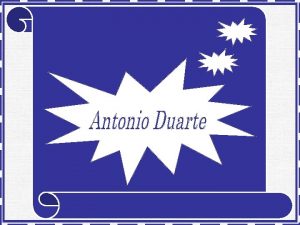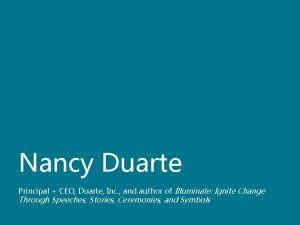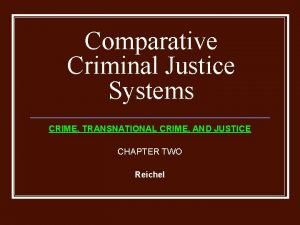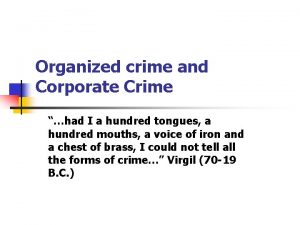TRANSNATIONAL ORGANIZED CRIME Paulina Duarte Secretariat for Multidimensional

























- Slides: 25

TRANSNATIONAL ORGANIZED CRIME Paulina Duarte Secretariat for Multidimensional Security October 1, 2015

OUTLINE 1. 2. 3. 4. Brief introduction to the topic Conceptualizing and characterizing the phenomenon of TOC Overview of TOC’s situation in the Americas Some challenges that hinder adequate measurement of the phenomenon 5. Instruments, forums, and mechanisms of the inter-American system that make a coordinated regional response feasible 6. Proposal

INTRODUCTION • The violence in the Hemisphere can, to a large extent, be attributed to organized crime’s growing activity, adaptability, and expansion • In recent years we see types of transnational crimes that respect no borders • The violence organized criminal groups unleash, no matter the kind or magnitude, affects each and every one of the countries in the region • The situation has become natural and normal – At an individual level population’s over-adaptation – At a State level lack of criminal prosecution • There is a need not only for greater coordination and linkage domestically between different levels of government and State institutions, but also regionally and internationally • In the fight against TOC, multilateral policy continues to be relevant and more necessary than ever. This is one of the avenues that needs strengthening and revitalizing.

CONCEPTUALIZING AND CHARACTERIZING THE PHENOMENON • The United Nations Convention against Transnational Organized Crime (UNTOC) represents the principal international legal instrument for fighting organized crime • Main criteria – – Numerical criterion Geographical space criterion transnational space Profit-driven criterion Crime-driven criterion


SITUATION IN THE AMERICAS • Factors that contribute to organized crime flourishing in the region: – Major producers of drugs, particularly cocaine – Increase in drug use – Easy availability of firearms – Access to modern communication and banking systems – Porous borders – High levels of corruption – Demand for illegal goods and services, as well as for individuals to exploit – Lack of formal education and high levels of unemployment and underemployment (youth) – Limitations of criminal justice systems

SITUATION IN THE AMERICAS • • • Drug trafficking Arms trafficking Migrant smuggling Trafficking in persons Kidnappings and extortion Trafficking of illegal goods/markets Illegal mining Criminal gangs Prisons Money laundering

SITUATION IN THE AMERICAS • South America, Central America, and the Caribbean are among the most five most violent regions in the world • 66% of violent homicides in the Americas are committed with firearms, and many are related to drug trafficking and availability of arms • 70% of the homicides are committed with illegal arms • The majority of the victims are young men between the ages of 15 and 29 years of age

SITUATION IN THE AMERICAS • Drug trafficking as the main source of profits from TOC, and from there TOC has diversified into other illegal businesses • Reduction of 33% in cocaine seizures (2009 -2013): – All sub-regions except South America had a drop in seizures between 2009 and 2011 – All the sub-regions except South America had an increase between 2011 and 2013 – The Caribbean is the sub-region which had the largest increase during the 2009 -2013 period • 38% decrease in cannabis seizures between 2009 and 2013 – All sub-regions except the Caribbean had a decrease in seizures during the 2009 -2011 period – All sub-regions except the Caribbean had an increase during the 2011 -2013 period – Central America had the largest increase in seizures during the 2009 -2013 period Source: UNODC

SITUATION IN THE AMERICAS • It is estimated that over 214 million people in the world are international migrants • 57. 5 million live in the Americas • It is estimated that annually over 1. 5 million migrants use the services of traffickers to reach their destination • The illegal migration business generated US$6. 6 billion a year • Latin America and the Caribbean reported 3, 178 kidnappings to the police in 2013 • Data on extortion is even more incomplete – There is no regional tool that allows for a systematic and comparable collection of official data about this crime

SITUATION IN THE AMERICAS • Between 2010 and 2012 practically all countries in the world had cases of human trafficking and at least 510 trafficking routes were identified • It is estimated that human trafficking affects 1. 8 million people in the Hemisphere • According to the ILO, it is estimated that just in Latin America and the Caribbean the profits stemming from forced labor are US$12 billion a year • The flows of human trafficking are mostly domestic and/or sub-regional • Children are 30% of the victims of human trafficking, while the other 70% are adults, the majority of whom are women

SITUATION IN THE AMERICAS • World Economic Forum’s Council on Illicit Trade and Organized Crime global impact of trade in counterfeit products is approximately US$650 billion and between US$20 to US$40 billion stem from environmental crimes • The World Health Organization (WHO) estimates that: – 10% of the medicines sold in developing countries are counterfeit – In some parts of Asia, Africa, and Latin America counterfeit medicines on the market may reach 30%. • The World Wide Fund for Nature more than 10% of illegal wildlife trafficking in the world comes from South America and is valued at some US$10 billion • Illegal mining is directly linked to an array of crimes like child exploitation, money laundering, trafficking in persons, illegal arms trafficking, among others • It has an adverse impact on the environment and people’s health

SITUATION IN THE AMERICAS • The gang phenomenon topic of concern – Crimes, insecurity, and violence they generate • Most crimes committed by gangs are related to common crime • Cases of links between gangs and some kinds of organized crime – Drug distribution, arms trafficking, trafficking in persons, among others • The link between gangs and organized crime is a topic that demands greater information, analysis, and detail • The gang phenomenon in principle is a social phenomenon

SITUATION IN THE AMERICAS • From 2000 to 2010, the prison population increased 30% in the Hemisphere • The rates of overcrowding in prisons is : – – – 116% in the Americas 178% in Central America 152% in the Caribbean 152% in South America 107% in North America • According to IMF data, money laundering represents between 2% and 5% of global GDP, which is equivalent to between US$1. 5 and US$2 trillion dollars annually • Money laundering in Latin America is between 2. 5% and 6. 3% of annual regional GDP

MEASUREMENT CHALLENGES Two approaches: the direct and the contextual – Direct focuses on the specific characteristics and functioning of groups involved in transnational crime. – Contextual encompasses three axes: 1. Kinds of responses the State provides with regard to organized crime 2. Social, institutional, demographic, labor, economic, and geographic facilitators, among others 3. Civil society’s level of organization, activism, and mobilization • Methodologies for measuring TOC are focused on the direct approach.

MEASUREMENT CHALLENGES Two approaches: the direct and the contextual – Direct focuses on the specific characteristics and functioning of groups involved in transnational crime. – Contextual encompasses three axes: 1. Kinds of responses the State provides with regard to organized crime 2. Social, institutional, demographic, labor, economic, and geographic facilitators, among others 3. Civil society’s level of organization, activism, and mobilization • Methodologies for measuring TOC are focused on the direct approach.

MEASUREMENT CHALLENGES • 2 kinds of problems: – Nature of the phenomenon illicit activities are conducted in a concealed and clandestine manner • Estimate based on the visible part of TOC (the tip of the iceberg) – Methodological questions • Lack of standardization in: – – – General and broad definition Indicators Measurement methodologies Data collection tools Information sources – Time spans for measurement and collection • Absence of data or disperse data Undermines the quality, validity, and comparability

Inter-American System Inter-American instruments in force: • Inter-American Convention on Mutual Assistance in Criminal Matters (1992) • Inter-American Convention against Corruption (1996) • Inter-American Convention against the Illicit Manufacturing of and Trafficking in Firearms, Ammunition, Explosives, and other Related Materials (1997) • Declaration on Security in the Americas (2003) • Comprehensive Inter-American Cybersecurity Strategy (2004) • Hemispheric Plan of Action against Transnational Organized Crime (2006) • Declaration of Brasilia (2014) • Second World Plan to Combat the Trafficking of Persons in the Western Hemisphere (2014)

Inter-American System Existing inter-American forums: • Meeting of Authorities Responsible for Penitentiary and Prison Policies • Meeting of Forensic Specialists in the Americas • Meeting of National Authorities on Transnational Organized Crime • Meeting of National Authorities on Trafficking in Persons • CIFTA Consultative Committee • Meeting of CIFTA States Parties • Meeting of Ministers Responsible for Public Security in the Americas • CICAD and its working groups and experts

Inter-American System Available inter-American mechanisms: • Mechanism for Follow-up of the Implementation of the Inter. American Convention against Corruption (MESICIC) • Multilateral Evaluation Mechanism (MEM) for measuring counter-drug activities

CONCLUSIONS • TOC cannot be addressed in an isolated fashion • Lack of coordination and linkage in the response only foster organized crime, allowing for its expansion • Multilateral forums take on importance and relevance • In addition to UNTOC and its three protocols, the countries of the Hemisphere have important tools and initiatives available to cooperate in the fight against organized crime – Leadership and as a reference in the fight against TOC • The inter-American system offers a regulatory and institutional framework by which to respond in a coordinated fashion to the different challenges presented by TOC

PROPOSAL Proposal for addressing TOC in the framework of CSH 2015 -2016 Date October 1, 2015 October 8, 2015 October 22, 2015 December 3, 2015 December 10, 2015 January 21, 2016 February 4, 2016 February 18, 2016 Topic General presentation on TOC Cyber-security Arms trafficking Prisons Money laundering Illegal mining and trafficking in goods Drug and chemical precursor trafficking Corruption March 4, 2016 Migrant smuggling and human trafficking Kidnappings and extortion; Emerging threats Criminal gangs April 7, 2016 April 21, 2016 Responsible body SMS SMS Could be a CSH-CAJP joint meeting SMS SMS At each meeting we will seek to: • Learn the specific situation of each topic at a hemispheric level • Learn the initiatives of the General Secretariat on the matter • Learn the policies and/or initiatives of member states

PROPOSAL • Assessment of the effectiveness of instruments, forums, and mechanisms – Through mechanisms designed and coordinated by the General Secretariat – Participation and involvement of member States is vital • Review of Hemispheric Action Plan approved in 2006 – Creation of a CSH Working Group to review the Action Plan’s effectiveness § The work will be guided by the inputs provided during the technical meetings and mechanisms designed – Convening of a meeting of national authorities on TOC (first half of 2016) in order to consider and approve a revised version of the Hemispheric Action Plan

PROPOSAL TOC Schedule 2015 -2016 Date Topic October 2015 - April 2016 Address specific topics and present inputs from the General Secretariat and member states 2015/2016 Creation of a CSH Working Group to review the Hemispheric Action Plan, as well as the pertinent mandates regarding TOC First half of 2016 Hold a meeting of authorities in the area of TOC to consider and approve a new Hemispheric Action Plan (2016 -2026? ) Proposed work schedule and methodology will also be used to comply with three of the pending mandates in AG/RES. 2866 (XLIV-O/14) with regard to TOC: • Paragraph 39 joint meeting of CSH and CAJP • Paragraph 40 CSH assessment of “existing coordination structures and mechanisms…”. • Paragraph 41 virtual conference or teleconference in the framework of CSH

TRANSNATIONAL ORGANIZED CRIME Paulina Duarte Secretariat for Multidimensional Security October 1, 2015
 Transnational crime and the developing world
Transnational crime and the developing world Transnational crime definition
Transnational crime definition South side loco
South side loco Organized crime osrs
Organized crime osrs Hungarian mafia
Hungarian mafia War making and state making as organized crime
War making and state making as organized crime Honours secretariat
Honours secretariat Public appointments secretariat
Public appointments secretariat Agri benchmark
Agri benchmark Secretariat scene
Secretariat scene Pacific island forum secretariat
Pacific island forum secretariat Secretariat family tree
Secretariat family tree Tâches effectuées rapport de stage secrétariat
Tâches effectuées rapport de stage secrétariat Unep secretariat
Unep secretariat Literacy and numeracy secretariat
Literacy and numeracy secretariat Asean secretariat
Asean secretariat Honours and appointments secretariat
Honours and appointments secretariat Trans kalahari corridor secretariat
Trans kalahari corridor secretariat Institute of secretariat training and management
Institute of secretariat training and management General secretariat for development planning
General secretariat for development planning Cg digital secretariat
Cg digital secretariat Cites secretariat
Cites secretariat Duarte slidedoc
Duarte slidedoc Dr alejandro duarte
Dr alejandro duarte Raquel duarte-davidson
Raquel duarte-davidson Seo antonio duarte
Seo antonio duarte

